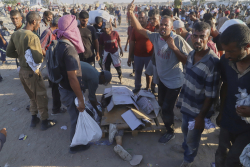In a hypothetical conflict with Russia, US and NATO aircraft could link with ground FARP elements in impromptu runways close to the battlefield and rearm and refuel.
In a near-peer conflict, US air power would very likely require sustained operations to prevail over the Chinese or Russian air forces.
Fighter jets would need to be ready for repeated sorties. The US Air Force has acknowledged the requirement for sustained operations, and has developed a plan to address it: the “Forward Arm and Refueling Point” framework, or FARP.
About the Air Force’s “Forward Arm and Refueling Point” Strategy
The US military has plenty of resources to refuel aircraft mid-air. This capability extends the range of strategic bombers, fighter jets, surveillance aircraft, and transport planes significantly and enables global operations. This was most recently illustrated during June’s “Operation Midnight Hammer,” in which several B-2 Spirit stealth bombers conducted an 18-hour flight from Missouri to strike targets inside Iran before returning—a mission enabled by mid-air refueling.
However, rearming aircraft mid-air is, at least for now, impossible. Accordingly, the FARP concept is aimed at quickly rearming and refueling aircraft on the ground. The US military has been drilling FARP in remote and unconventional locations, including highways. For example, in a hypothetical conflict with Russia, US and NATO aircraft could link with ground FARP elements in impromptu runways close to the battlefield and rearm and refuel. Such landings also complicate US aircraft’s targeting, because adversaries are less able to predict where they might rearm and refuel.
The Air Force Is Putting “FARP” into Practice
Recently, the Air National Guard drilled “Distributable Integrated Combat Turn,” or D-ICT, operations under the FARP concept. D-ICT is a tactic that aims to keep fighter jets fueled, armed, and back in action in under an hour. During the drills, two C-130 transport aircraft packed with fuel and munitions refueled and rearmed several F-35 Lightning II stealth fighter jets and F-15 Eagle fighter jets.
“The Distributed ICT epitomizes the essence of Agile Combat Employment,” Air National Guard Lieutenant Colonel Doug Ferro, the commanding officer of the 103rd Aircraft Maintenance Squadron, said in a press statement.
Sometimes, the maintainers were refueling and rearming several fighter jets at the same time.
“This enables Combat Air Forces to deliver lethal airpower with unprecedented agility by leveraging Mobility Air Forces platforms for rapid, distributed operations,” Ferro added.
According to the Air National Guard, the 103rd Aircraft Maintenance Squadron is so advanced in FARP operations that it is providing educational courses to other units.
“D-ICT enables us to project power rapidly, wherever needed. We understand that in the vast, contested spaces of our pacing-threat theaters, speed and flexibility are critical,” Air National Guard Colonel Michael Blair, the commanding officer of the 158th Fighter Wing, stated.
FARP operations can prove critical in a near-peer clash with China or Russia. If done correctly, they can “squeeze out” more sorties from the same number of aircraft.
About the Author: Stavros Atlamazoglou
Stavros Atlamazoglou is a seasoned defense journalist specializing in special operations and a Hellenic Army veteran (national service with the 575th Marine Battalion and Army HQ). He holds a BA from the Johns Hopkins University and an MA from the Johns Hopkins’ School of Advanced International Studies (SAIS). His work has been featured in Business Insider, Sandboxx, and SOFREP.
Image: Shutterstock.


















